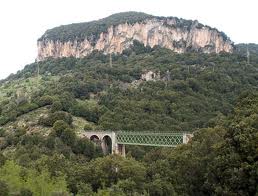By car
While it is possible to get around Sardinia by bus and train, doing so may well limit how fast you travel and where you go. If you can, hire a car. It is well worth the outlay, and it will allow you to visit some of the more remote and enchanting places and areas.
There are no toll highways in the island; the main axes are Porto Torres-Sassari-Oristano-Cagliari (Strada Statale [State Road] 131, European denomination E25) and its bifurcation to Nuoro (SS131 d.c.n.), Iglesias-Cagliari (SS130) [the SS130 and SS131 are the only fully 2 x 2-lane roads in Sardinia], the SS125 (Cagliari-Villasimius), SS126 (Sant'Antioco-Carbonia-Iglesias-Guspini-Terralba), SS127 (Olbia-Tempio Pausania-Sassari), SS128 (East-Central Sardinia), SS129 (Orosei-Nuoro-Macomer), SS195 (Cagliari-SS126 through Pula), and the SS291 (Sassari-Alghero). Many other roads are also of great interest for the tourist, such as the SS133 (Tempio Pausania-Palau) or the Chia-Teulada 'panoramica'.
Many roads are narrow and wind through hilly terrain; be careful and do not hesitate to use your car horn to signal your presence: because of the light traffic, oncoming drivers may not expect to encounter other vehicles. Remember that locals know their roads: they can drive faster than you because of that, do not try to race with them! Beware also of domesticated animals (sheep, goat, cows, pigs) crossing roads in large or small units, especially in rural areas.
Engine overheating may happen in summer because of the heat/topography combination; take the usual precautions.
Paving is generally good on the main axes; it may vary for secondary axes and urban areas, but is often in correct conditions. There are local unpaved roads of touristic interest; these can be in any state, especially after heavy rains, so it is better to go there with a sturdy 4-wheel drive car.
Traffic can become heavy during summer in and around touristic areas, in particular on the SS 125, 126, 127, 195, 291.
A roadmap and a GPS tracking unit (handheld ones are also useful for trekking) are recommended: road signs, in particular directions, are somewhat lacking, especially on secondary roads, whereas crossroads are generally well signalled.
Beware of high winds; gusts in excess of 100 kph (60 mph) are common from September to April.
Many villages have installed speed traps and automated cameras at the entrances: these are almost always signalled and fines for speeding are generally heavy. Quite often, you will cross villages with no pavements, and find elder people there: drive with caution.
By bus
Regular, cheap buses between the main centres: Cagliari, Sassari, Alghero, Nuoro etc. You may end up changing buses (or trains) in Macomer. Less frequent buses, but worth persevering for the smaller villages. The main bus company is the public-owned and managed ARS.
By sailboat
Sailing is one of the best way to see Sardinia. Most charters offers many solutions from bareboat to crewed and cabin charter, with all the type of the boats.
- ItalyCharter, ☎ +39 3483337796 (info@italycharter.it)
By train
Regular trains from the edge of Alghero to Sassari and from Sassari to Cagliari, although buses are usually quicker. Change at Macomer for trains or buses to Nuoro. Less frequent trains on this and other routes. Both Trenitalia and Ferrovie della Sardegna operate trains in the Island.
In the summer period, twice a week, there's a small train that travels from Sassari to Tempio and back. It runs especially for tourists and is highly recommended. The train in called "trenino verde".
By bicycle
At many places it is possible to rent a bike quite cheaply, for as little as 9 euros per 24 hours. Compared to the scarce local bus connections a bicycle provides great flexibility for local exploration. With high quality roads and great scenery the bike is very pleasant to ride.





Nessun commento:
Posta un commento